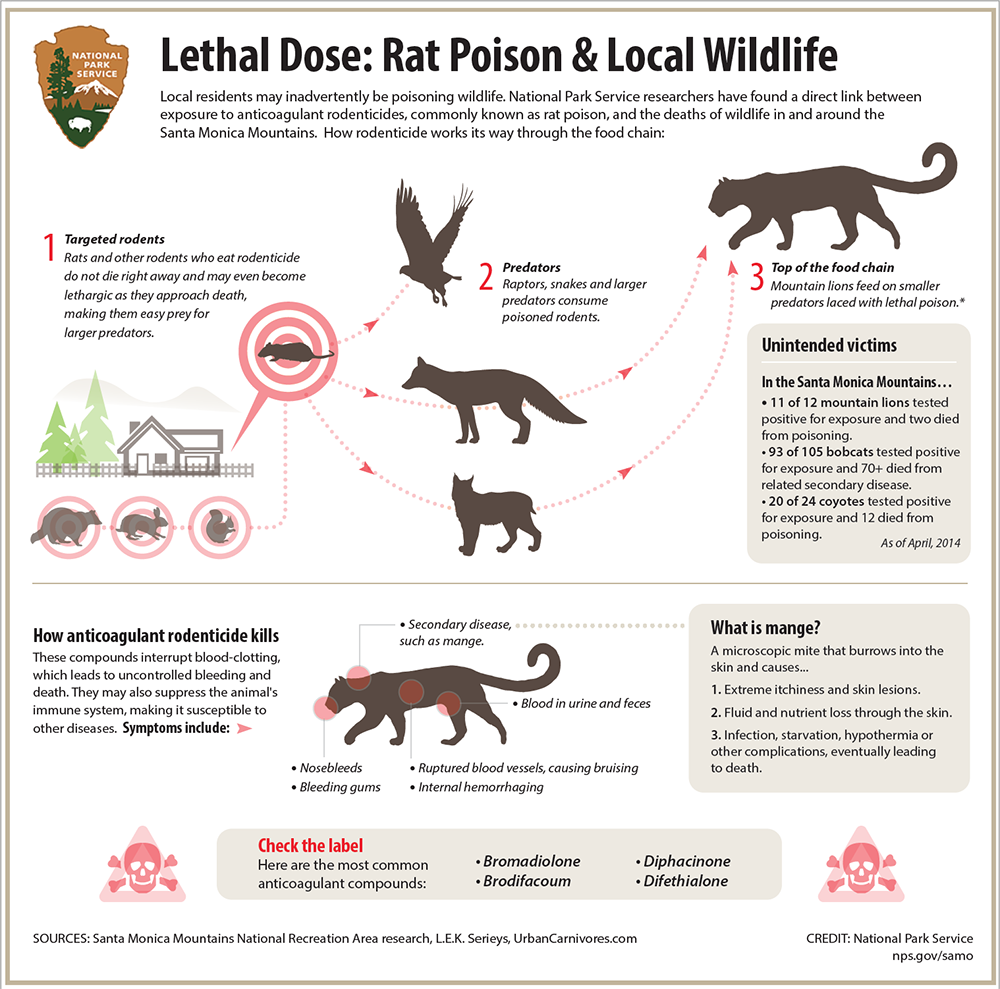
On July 6, we joined many other environmental organizations calling on the Environmental Protection Agency (EPA) to ban rodenticides instead of relicensing them, particularly brodifacoum, bromadiolone, difethialone, difenacoum, diphacinone and chlorophacinone. These anticoagulant “rodenticides”, a misnomer hiding their most important ecological effect – that of killing mid-level and top-level predators, should be banned and non-poison based methods preferred for controlling rodents.
The EPA is conducting an Ecological Risk Assessment of rodenticides, giving it the opportunity to start the process of eliminating the most dangerous ones. Regardless of federal action or inaction, our local governments should not use these rodenticides and should discourage their use by others to protect our local ecosystems.
Anticoagulant Rodenticides Are Predator Killers
While all rat poisons are problematic, anticoagulant poisons cause rodents to slowly bleed to death internally. During the process, rodents become lethargic and unwary of predators, leaving them as inadvertently poisoned bait. Predators eating these dying rodents or scavenge off of their dead bodies ingest the poison still in the rodents’ systems. That poison may be enough to kill the predator, especially where rodenticides are in widespread use. The newer, “second-generation” anticoagulants can persist for weeks in an animal’s body, accumulating and gradually poisoning top predators.
Research in Southern California and elsewhere shows bobcats, coyotes, and mountain lions strongly affected by rodenticides. Even when they are not directly killed by poison, they become weakened and hunt less effectively. These animals are also more vulnerable to secondary infections like mange, a type of skin disease caused by parasitic mites, the eventual effects of which can cause death. Predatory and scavenging birds like hawks and owls with relatively smaller body masses may be even more vulnerable to the accumulating poison.
The direct human impact should not be ignored either, with thousands of calls annually to poison control centers due to small children ingesting rodenticides.
Impacts to our Local Wildlife
Anticoagulant rodenticides harm ecosystems everywhere, and the Bay Area is no exception. The predators found to be harmed in Southern California are important local predators in Santa Clara and San Mateo Counties. Mountain lions in particular are on the edge of survival, with lions in our region granted “candidate” status to be listed as threatened under the California Endangered Species Act. Both local and migrating predatory birds can also suffer from poisoning via rodenticide. In addition, many of our predators live near human communities where the risk of poisoning is much greater than in truly remote parts of the country.

Eliminating Anticoagulant Rodenticides Locally
Inaction by the EPA does not prevent action locally to protect the predators that are essential to our ecosystems. Unfortunately, laws enacted in 40 states, including California, place limits on local governments’ ability to ban rodenticides. Those laws certainly should be reassessed.
Regardless of state limitations, local governments should not use rodenticides and should educate the public on alternatives. Of note are some local governments that have taken action. Palo Alto and its contractors do not use anticoagulant rodenticides. Mountain View has apparently found a way to restrict their use in the vicinity of burrowing owls in the North Bayshore area. Morgan Hill has stopped using all rodenticides and educates its residents on alternatives. Santa Clara County parks stopped using any rodenticides since 2003 other than burrow fumigants like carbon dioxide in Martial Cottle Park.
Taking even more steps along the line of what these local governments have done can help ensure our local ecosystems with healthy predators can persist for coming generations. Let’s hope that at some point the EPA will support this form of environmental protection.

Leave a Reply